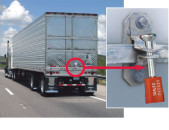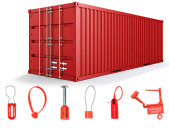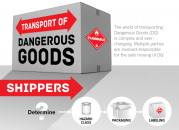Seals Series, Volume 3 — Seals are a great, underappreciated hazmat security tool. In our last couple of posts, we’ve talked about situations where seals are essential in Dangerous Goods security, and where seals are a better choice than locks. But seals by themselves can only do so much. To fully exploit their potential, you…
Dangerous Goods Report | Vol. 5
Lithium Battery Shipping—Retail Rolls with the Changes. Cover Story: Challenging skies for lithium battery shippers. As lithium battery shipping regulations get even more complex and restrictive, retailers must adopt new processes and tactics. A look inside UN-certified packaging. Do you need it? Is it worth it? And what do all those letters and numbers mean?…
Dangerous Goods security: 5 reasons to choose a seal over a lock
Seals Series, Volume 2 — Since our high school locker days, most of us are conditioned to think that the best way to keep things secure is with a lock. In the Dangerous Goods world, though, locks aren’t always the best choice. When is a seal better than a lock? You might be surprised: …
11 places security seals are essential in Dangerous Goods
Seals Series, Volume 1 — If you’re in the Dangerous Goods business, you probably use security seals somewhere. Maybe lots of somewheres. But you might not realize how many ways and places DG professionals put seals to work. A closure device that can be opened only once can protect more than you might think. Locks…
FAA Reauthorization Legislation Focused on Lithium Batteries
Bob Richard and Neil McCulloch co-contributed to this article. When a US Senator proposes to spend tax dollars on a committee to “promote research and new standards for the safe manufacture, use or transportation of lithium batteries,” I can only sigh in frustration. This is exactly what was recently proposed by Sen. Bill Nelson, D-Fla.. …
DG Advisory Council tries to make sense of lithium battery provisions
Why would anyone choose to spend three days in Washington a few days after the city was shut down for the Storm of the Decade? That’s what 70 or so DG experts asked ourselves, before we got down to the serious business of the Dangerous Goods Advisory Council January quarterly meeting in Alexandria last week.…
USDOT/FMCSA announces delay to new Medical Exam Report and Certificate compliance date
Today the United States Department of Transportation’s (USDOT) Federal Motor Carrier Safety Administration (FMCSA) formally made the anticipated announcement of which rumor had circulated in the regulatory community for the last several days. FMCSA offered a “grace period” of 120 days regarding mandatory use of the new Medical Examination Report (MER) (Federal Form MCSA-5875) and…
New FMCSA Medical Examination Forms Released
On Monday December 7th, 2015, the Federal Motor Carrier Safety Administration (FMCSA) posted example copies of the revised Medical Examination Report Form (MCSA-5875) and Medical Examiner’s Certificate (MCSA-5876) on the FMCSA website. See below: https://www.fmcsa.dot.gov/medical/driver-medical-requirements/medical-applications-and-forms The FMCSA mandated use of the new forms in a Final Rule amending the FMCSR published in the Federal Register…
Infographic | The Movement of Dangerous Goods
Moving Dangerous Goods (DG) safely involves the coordinated actions of shippers, carriers, and receivers. This infographic provides a high-level look at some of the facts and figures behind the 1.4 million DG shipments that take place each day. To learn more about these and other important DG topics Contact Labelmaster





